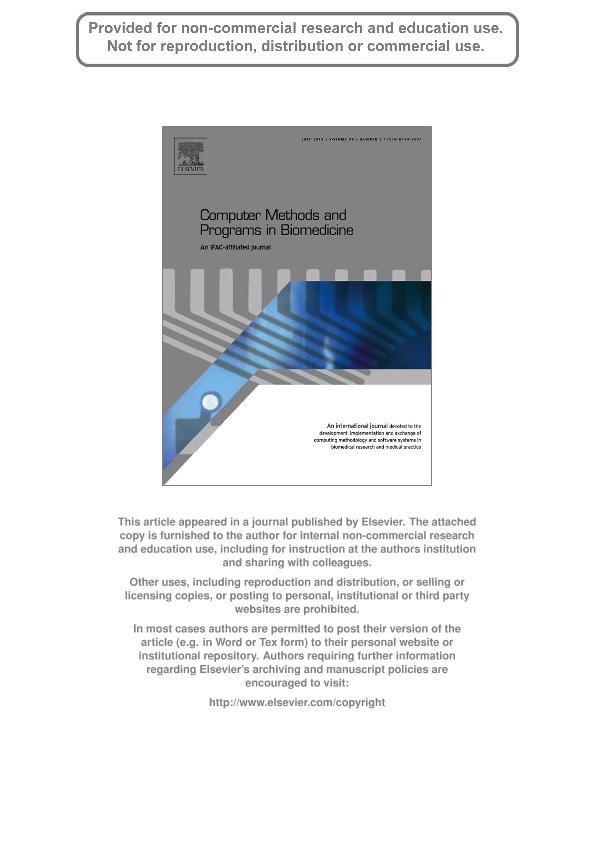Mostrar el registro sencillo del ítem
dc.contributor.author
Fernandez, Elmer Andres

dc.contributor.author
Souza Neto, E. P.
dc.contributor.author
Abry, P.
dc.contributor.author
Macchiavelli, R.
dc.contributor.author
Balzarini, Monica Graciela

dc.contributor.author
Cuzin, B.
dc.contributor.author
Baude, C.
dc.contributor.author
Frutoso, J.
dc.contributor.author
Gharib, C.
dc.date.available
2023-02-22T12:30:03Z
dc.date.issued
2010-07
dc.identifier.citation
Fernandez, Elmer Andres; Souza Neto, E. P.; Abry, P.; Macchiavelli, R.; Balzarini, Monica Graciela; et al.; Assessing erectile neurogenic dysfunction from heart rate variability through a Generalized Linear Mixed Model framework; Elsevier Ireland; Computer Methods And Programs In Biomedicine; 99; 1; 7-2010; 49-56
dc.identifier.issn
0169-2607
dc.identifier.uri
http://hdl.handle.net/11336/188530
dc.description.abstract
Background: The low (LF) vs. high (HF) frequency energy ratio, computed from the spectral decomposition of heart beat intervals, has become a major tool in cardiac autonomic system control and sympatho-vagal balance studies. The (statistical) distributions of response variables designed from ratios of two quantities, such as the LF/HF ratio, are likely to non-normal, hence preventing e.g., from a relevant use of the . t-test. Even using a non-parametric formulation, the solution may be not appropriate as the test statistics do not account for correlation and heteroskedasticity, such as those that can be observed when several measures are taken from the same patient. Objectives: The analyses for such type of data require the application of statistical models which do not assume a priori independence. In this spirit, the present contribution proposes the use of the Generalized Linear Mixed Models (GLMMs) framework to assess differences between groups of measures performed over classes of patients. Methods: Statistical linear mixed models allow the inclusion of at least one random effect, besides the error term, which induces correlation between observations from the same subject. Moreover, by using GLMM, practitioners could assume any probability distribution, within the exponential family, for the data, and naturally model heteroskedasticity. Here, the sympatho-vagal balance expressed as LF/HF ratio of patients suffering neurogenic erectile dysfunction under three different body positions was analyzed in a case-control protocol by means of a GLMM under gamma and Gaussian distributed responses assumptions. Results: The gamma GLMM model was compared with the normal linear mixed model (LMM) approach conducted using raw and log transformed data. Both raw GLMM gamma and log transformed LMM allow better inference for factor effects, including correlations between observations from the same patient under different body position compared to the raw LMM. The gamma GLMM provides a more natural distribution assumption of a response expressed as a ratio. Conclusions: A gamma distribution assumption intrinsically models quadratic relationships between the expected value and the variance of the data avoiding prior data transformation. SAS and R source code are available on request.
dc.format
application/pdf
dc.language.iso
eng
dc.publisher
Elsevier Ireland

dc.rights
info:eu-repo/semantics/openAccess
dc.rights.uri
https://creativecommons.org/licenses/by-nc-sa/2.5/ar/
dc.subject
ERECTILE DYSFUNCTION
dc.subject
GAMMA DISTRIBUTION
dc.subject
HEART RATE VARIABILITY
dc.subject
SUBJECT SPECIFIC MODELS
dc.subject
SYMPATHO-VAGAL BALANCE
dc.subject.classification
Biotecnología relacionada con la Salud

dc.subject.classification
Biotecnología de la Salud

dc.subject.classification
CIENCIAS MÉDICAS Y DE LA SALUD

dc.title
Assessing erectile neurogenic dysfunction from heart rate variability through a Generalized Linear Mixed Model framework
dc.type
info:eu-repo/semantics/article
dc.type
info:ar-repo/semantics/artículo
dc.type
info:eu-repo/semantics/publishedVersion
dc.date.updated
2023-02-02T23:15:19Z
dc.journal.volume
99
dc.journal.number
1
dc.journal.pagination
49-56
dc.journal.pais
Irlanda

dc.description.fil
Fil: Fernandez, Elmer Andres. Universidad Nacional de Córdoba. Facultad de Ingeniería; Argentina. Consejo Nacional de Investigaciones Científicas y Técnicas. Centro Científico Tecnológico Conicet - Córdoba; Argentina
dc.description.fil
Fil: Souza Neto, E. P.. Centre National de la Recherche Scientifique; Francia. Universite Claude Bernard Lyon 1. Institut de Physique Nucléaire de Lyon.; Francia
dc.description.fil
Fil: Abry, P.. Centre National de la Recherche Scientifique; Francia
dc.description.fil
Fil: Macchiavelli, R.. Universidad de Puerto Rico; Puerto Rico
dc.description.fil
Fil: Balzarini, Monica Graciela. Consejo Nacional de Investigaciones Científicas y Técnicas. Centro Científico Tecnológico Conicet - Córdoba; Argentina. Universidad Nacional de Córdoba; Argentina
dc.description.fil
Fil: Cuzin, B.. Universidad Nacional de Córdoba; Argentina
dc.description.fil
Fil: Baude, C.. Hôpital Edouard Herriot; Francia
dc.description.fil
Fil: Frutoso, J.. Universite Claude Bernard Lyon 1. Institut de Physique Nucléaire de Lyon.; Francia
dc.description.fil
Fil: Gharib, C.. Universite Claude Bernard Lyon 1. Institut de Physique Nucléaire de Lyon.; Francia
dc.journal.title
Computer Methods And Programs In Biomedicine

dc.relation.alternativeid
info:eu-repo/semantics/altIdentifier/url/https://www.sciencedirect.com/science/article/abs/pii/S0169260709002910
dc.relation.alternativeid
info:eu-repo/semantics/altIdentifier/doi/http://dx.doi.org/10.1016/j.cmpb.2009.11.001
Archivos asociados
